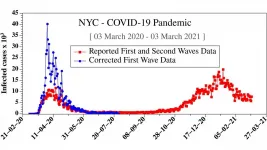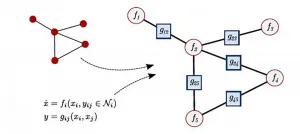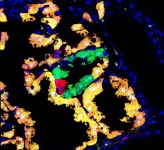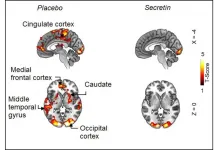(Press-News.org) PROVIDENCE, R.I. [Brown University] -- What motivated Americans to wear masks and stay socially distanced (or not) at the beginning of the COVID-19 pandemic? More often than not, it was partisanship, rather than perceived or actual health risk, that drove their behavior, according to a new study co-authored by researchers at Brown University.
By analyzing the results of two online surveys of more than 1,100 adults in total, Mae Fullerton, a Class of 2021 Brown graduate, and Steven Sloman, a professor of cognitive, linguistic and psychological sciences, found that in spring and fall 2020, political partisanship was the strongest predictor of whether someone would wear a mask or practice social distancing to stem the spread of novel coronavirus.
Those who identified as liberal or moderate overwhelmingly said they wore masks and practiced social distancing, even when they believed their risk of contracting the novel coronavirus was minimal. Those who identified as conservative were much less likely to say they always wore a mask or socially distanced, even when they believed they were at high risk of contracting the virus and falling ill with COVID-19.
The findings were published on Friday, June 18, in the Journal of Health Psychology. Sloman said the results show that many Americans tend to remain fiercely loyal to their like-minded communities, even in situations where their health is on the line.
"It turns out that life is not the most important thing to people," Sloman said. "Many people are putting their partisan leanings ahead of their self-interest. We're willing to outsource our thinking to other people in our communities, even when our lives are at stake."
At the start of the study, Fullerton and Sloman predicted that respondents' risk of becoming sick with COVID-19, or at least their perception of risk, would be the primary factor guiding their mask uptake and social distancing. Instead, they found almost no correlation between behavior and risk -- whether perceived or real. Among survey respondents who considered themselves to be at high risk of contracting COVID-19, 59% reported they had limited their encounters to two or fewer people in the prior week. Meanwhile, among those who perceived they were at low risk of contracting COVID-19, 58% reported the same. In other words, people who felt they were in a high-risk group didn't seem any more likely to practice social distancing than their lower-risk peers.
The same was true of mask-wearing: 62% of those who reported that they were elderly or had no health insurance said they always wore masks when they anticipated coming within 6 feet of others, compared to 61% of those who were younger and had health insurance.
They found, in fact, that the biggest predictor of whether someone was likely to wear a mask and practice social distancing wasn't risk but political partisanship. Among those who identified as liberal or moderate, 66% reported that they always wore masks when they anticipated coming within 6 feet of others, compared to 45% of those who identified as conservative. And while 95% of self-identified liberals and moderates said they thought it was important to wear a mask to prevent the spread of the virus, only 74% of self-identified conservatives said they believed the same. Conservative-leaning respondents were also significantly less likely to practice social distancing (31%) than their moderate or liberal counterparts (49%).
Crucially, the researchers also found a high correlation between compliance with stay-at-home orders -- which were in effect for 95% of Americans at the time of the survey -- and peer agreement. Among those who said they believed it was "extremely important" to comply with orders to stay socially distanced, 86% said their peer group reportedly held similar views.
Fullerton said the findings confirm something behavioral scientists have known for a long time: that most people's health decisions have more to do with the behaviors of people around them than with scientific evidence. Studies have shown, for example, that people are more likely to quit smoking if someone close to them has quit smoking recently, and that the amount of food a person eats on Thanksgiving is often driven by how much others at the table are eating.
"This study supports other findings that preventive behavior is strongly influenced by social norms," Fullerton said. "People clearly are more motivated by their politics, their culture and their peers than by their likelihood of catching the virus and possibly suffering from terrible side effects. This suggests that communicating the risks of not wearing a mask and not staying socially distanced might not be the most effective way to stop the spread of a virus."
Both Fullerton and Sloman said the reason many conservative Americans didn't wear masks and socially distance may be in part because the people they trusted most -- people who include, according to past studies, family doctors, local television hosts and church leaders -- weren't wearing masks or staying distanced either. Getting buy-in from influential community figures, then, may be key in ensuring more unified compliance with public health recommendations in the future. And that might start with bringing more widely known trusted personalities on board, from television hosts to beloved celebrities to leading federal lawmakers.
"In some cases, communicating the risks via government-appointed experts might not be as effective as communicating the risks via political leaders people know and respect," Fullerton said. "That's a good lesson we can remember the next time we're facing a public health crisis."
Ultimately, both Fullerton and Sloman said, the key to keeping people safe and healthy is understanding their most sacred values. For example, Sloman said, many libertarians didn't refuse to wear masks just because some of their local politicians vocally opposed masking; some perhaps did it because individual freedom is their most sacred value, and they believed mask mandates infringed on that freedom. Many older people at high risk of severe COVID-19 due to other health challenges, Fullerton said, may have chosen not to practice social distancing because, to them, the costs -- not meeting a new grandchild, for example -- outweighed the benefits -- potentially living a few years longer.
"Americans can't be boiled down to figureheads and followers or believers and non-believers," Sloman said. "Getting into people's heads is complicated, but it matters."
Other study contributors were Nathaniel Rabb, a project manager at the Policy Lab at Brown; Sahit Mamidipaka, a student at Northview High School in Georgia; and Lyle Ungar, a professor of computer and information science at the University of Pennsylvania. The research was supported in part by a donation from Adobe.
INFORMATION:
An analysis of survey data from more than 280,000 young adults ages 18-35 showed that cannabis (marijuana) use was associated with increased risks of thoughts of suicide (suicidal ideation), suicide plan, and suicide attempt. These associations remained regardless of whether someone was also experiencing depression, and the risks were greater for women than for men. The study published online today in JAMA Network Open and was conducted by researchers at the National Institute on Drug Abuse (NIDA), part of the National Institutes of Health.
"While we cannot establish that cannabis use caused the increased suicidality we observed in this study, these associations warrant further research, especially ...
What The Study Did: Researchers report their study found no association in SARS-CoV-2 positivity rates among health care workers wearing respirator masks compared with medical masks when performing nonaerosolizing routine patient care.
Authors: :Aldon Li, M.D., of the Southern California Permanente Medical Group in Riverside, California, is the corresponding author.
To access the embargoed study: END ...
WASHINGTON, June 22, 2021 -- Two COVID-19 pandemic curves emerged within many cities during the one-year period from March 2020 to March 2021.
Oddly, the number of total daily infections reported during the first wave is much lower than that of the second, but the total number of daily deaths reported during the first wave is much higher than the second wave.
This contradiction inspired researchers from the University of Nicosia in Cyprus to explore the uncertainty in the daily number of infections reported during the first wave, caused by insufficient contact tracing between March and April 2020.
In Physics of Fluids, ...
WASHINGTON, June 22, 2021 -- Emerging open-source programming language Julia is designed to be fast and easy to use.
Since it is particularly suited for numerical applications, such as differential equations, scientists in Germany are using it to explore the challenges involved in transitioning to all-renewable power generation.
Decarbonization implies a radical restructuring of power grids, which are huge complex systems with a wide variety of constraints, uncertainties, and heterogeneities. Power grids will become even more complex in the future, so new computational tools are needed.
In Chaos, from AIP Publishing, Potsdam Institute for Climate Impact Research (PIK) scientists describe a software package they built to enable the simulation of general dynamical ...
WASHINGTON, June 22, 2020 -- Most models explaining how viruses are transmitted focus on viral particles escaping one person to infect a nearby person. A study on the role of microscopic particles in how viruses are transmitted suggests pollen is nothing to sneeze at.
In Physics of Fluids, by AIP Publishing, Talib Dbouk and Dimitris Drikakis investigate how pollen facilitates the spread of an RNA virus like the COVID-19 virus. The study draws on cutting-edge computational approaches for analyzing fluid dynamics to mimic the pollen movement from a willow ...
Genetic mosaic individuals, which contain cells of different genotypes, arise naturally in multicellular organisms. In humans, the development of cancer - where one cell acquires a mutation that allows it to proliferate, while other cells don't - is a prime example of genetic mosaicism. But inversely, genetic mosaicism can be used to study and understand the development of disease.
A common quirk of nature used to understand genes
One experimental genetic mosaic approach is called Mosaic Analysis with Double Markers (MADM), in which genes are mutated in individual cells while, at the same time, the mutated cells are labelled in fluorescent colors. ...
Scientists at Nagoya University, with colleagues at Kyoto University in Japan, have uncovered a mechanism that allows a protein complex to bind to DNA without impeding some of the important processes of cell division. Their findings, published in the journal Cell Reports, could further understandings of developmental disorders arising from mutations in the gene that codes for the complex.
DNA condenses during cell division to form structures called chromosomes that are formed of two identical copies, called sister chromatids. These sister chromatids are bound together by proteins called cohesins, until it is time for them to be pulled apart and directed into the newly formed cells. Scientists know quite a bit about the ...
The venom of a caterpillar, native to South East Queensland, shows promise for use in medicines and pest control, Institute for Molecular Bioscience researchers say.
The Doratifera vulnerans is common to large parts of Queensland's south-east and is routinely found in Toohey Forest Park on Brisbane's southside.
Dr Andrew Walker has been researching the striking looking caterpillar since 2017.
"We found one while collecting assassin bugs near Toowoomba and its strange biology and pain-causing venom fascinated me," Dr Walker said.
Unlike The Very Hungry Caterpillar that charmed generations of children around ...
"Detecting primordial black holes opens up new perspectives to understand the origin of the Universe, because these still hypothetical black holes are supposed to have formed just a few tiny fractions of a second after the Big Bang. Their study is of great interest for research in theoretical physics and cosmology, because they could notably explain the origin of dark matter in the Universe". You can see stars in the eyes of the members of the team led by Professor Fuzfa, astrophysicist at UNamur, when talking about the perspectives of their research. This project is the result of an unprecedented collaboration between the UNamur ...
Researchers from the Turku PET Centre and Technical University of Munich have discovered a new mechanism controlling satiation. According to the recently published study, the hormone secretin induces satiation by activating brown adipose tissue.
Brown adipose tissue is known for its ability to generate heat in response to cold exposure. Its activity has been proven to be connected to normal weight and glucose metabolism as well as lesser risks of cardiovascular diseases. Meals have also been shown to increase the thermogenesis in brown fat, but the significance of this phenomenon has been unclear. ...



